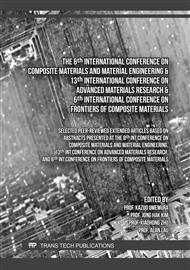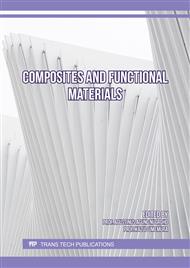[1]
Y. Hou, Y. Tai, C. Lira, F. Scarpa: The bending and failure of sandwich structures with auxetic gradient cellular cores, Composites Part A: Applied Science and Manufacturing 2013, 49, 119-131
DOI: 10.1016/j.compositesa.2013.02.007
Google Scholar
[2]
T.C. Lim: Auxetic Materials and Structures, Springer Singapore 2015.
Google Scholar
[3]
A. Bezazi, F. Scarpa: Mechanical behavior of conventional and negative poissons ratio thermoplastic polyurethane foams under compressive cyclic loading, International Journal of Fatigue 2007, 29, 922–930.
DOI: 10.1016/j.ijfatigue.2006.07.015
Google Scholar
[4]
S. Hou, T. Li, Z. Jia, Z, J. Wang: Mechanical properties of sandwich composites with 3d-printed auxetic and non-auxetic lattice cores under low velocity impact, Materials & Design 2018, 160, 1305–1321.
DOI: 10.1016/j.matdes.2018.11.002
Google Scholar
[5]
H. Yang, B. Wang, L. Ma: Mechanical properties of 3D double-U auxetic structures, International Journal of Solids and Structures 2019, 180, 13–29.
DOI: 10.1016/j.ijsolstr.2019.07.007
Google Scholar
[6]
L.M. Gibson, B. Gopalan, S.V. Pisupati, L.J. Shadle: Image analysis measurements of particle coefficient of restitution for coal gasification applications, Powder Technology 2013, 247, 30-43.
DOI: 10.1016/j.powtec.2013.06.001
Google Scholar
[7]
Y. Shimaki, M. Arakawa: Low-velocity collisions between centimeter-sized snowballs: Porosity dependence of coefficient of restitution for ice aggregates analogues in the solar system, Icarus 2012, 221, 310–319.
DOI: 10.1016/j.icarus.2012.08.005
Google Scholar
[8]
M. Yasui, M. Arakawa, Y. Yoshida, K. Matsue, S. Takano: Effects of oblique impacts on the impact strength of porous gypsum and glass spheres: Implications for the collisional disruption of planetesimals in thermal
DOI: 10.1016/j.icarus.2019.113414
Google Scholar
[9]
D. Hui, P.K.A Dutta: new concept of shock mitigation by impedance-graded materials, Composites Part B: Engineering 2011, 42, 2181–2184.
DOI: 10.1016/j.compositesb.2011.05.016
Google Scholar
[10]
M.F. Sonnenschein, E. Nicoli, L. Ma, B.L. Wendt: Impact mitigation in layered polymeric structures, Polymer 2017, 131, 25–33.
DOI: 10.1016/j.polymer.2017.10.014
Google Scholar
[11]
P. Townsend, I. Mendoza, D. Townsend, Da. Townsend: Measuring the Capacity of a Proposed Vibration Isolator Using Viscoelastic Sheets, Materials Science Forum Vol. 1060, (2022)
DOI: 10.4028/p-4w9684
Google Scholar



